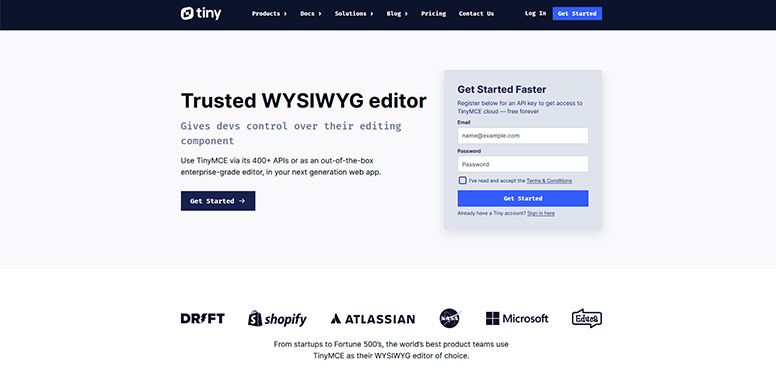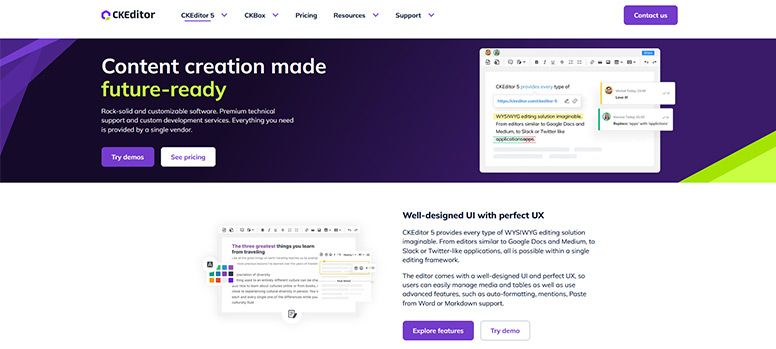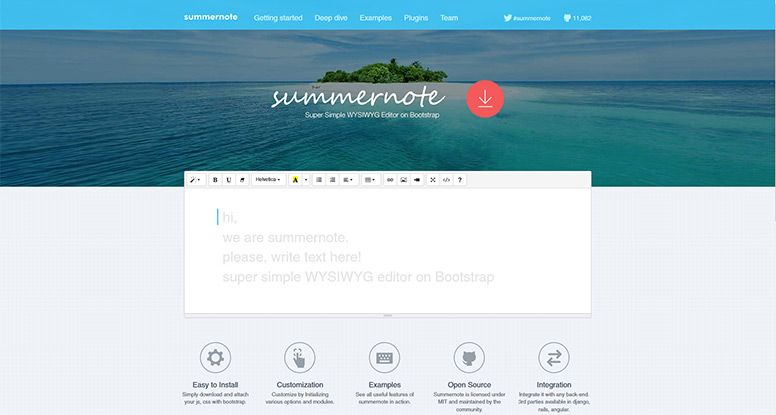
The Best jQuery and HTML WYSIWYG Plugins for Web Development
Web development can be a time-consuming and complex process, but with the right tools, it can be much more manageable.
One essential tool for web development is a WYSIWYG editor, which stands for "what you see is what you get." WYSIWYG editors allow developers to create and edit content visually, without having to write code manually. Find out more about the best jQuery and HTML WYSIWYG plugins for web development.
What are jQuery and HTML WYSIWYG Plugins?
jQuery and HTML WYSIWYG (What You See Is What You Get) plugins are invaluable tools for web developers seeking to streamline the process of creating and editing content on their websites. Here's a deeper dive into what these plugins entail:
-
Visual Editing Interface: At the core of jQuery and HTML WYSIWYG plugins is a visual editing interface that allows developers to interact with website content by using a word processor or design tool. Instead of manually writing HTML or CSS code, developers can use a drag-and-drop interface to manipulate elements on the page, such as text, images, videos, and more. This intuitive approach to content creation enables developers to see the changes they make in real time, enhancing productivity and creativity.
-
Ease of Use: One of the primary benefits of jQuery and HTML WYSIWYG plugins is their ease of use. These plugins are designed to be accessible to developers of all skill levels, from beginners to seasoned professionals. By abstracting away the complexities of HTML and CSS coding, WYSIWYG plugins empower developers to focus on the creative aspects of web design without getting bogged down by technical details. This democratization of web development tools makes it easier for individuals and businesses to create and maintain visually appealing websites.
-
Integration with jQuery and HTML: jQuery and HTML WYSIWYG plugins are typically built using either the jQuery JavaScript library or pure HTML and JavaScript. They leverage the rich functionality and cross-browser compatibility provided by these technologies to deliver a seamless editing experience across different web browsers and devices. Whether you're working with a jQuery-based plugin or an HTML-based one, you can expect robust performance and broad support for modern web standards.
-
Extensibility: Many jQuery and HTML WYSIWYG plugins offer extensibility through the use of plugins, themes, and customizable settings. Developers can enhance the functionality of these plugins by integrating additional features such as custom toolbars, content templates, spell-checking capabilities, and more. This extensibility allows developers to tailor the editing experience to their specific needs and preferences, further enhancing productivity and workflow efficiency.
-
Integration with Content Management Systems (CMS): jQuery and HTML WYSIWYG plugins are commonly integrated with popular content management systems (CMS) such as WordPress, Joomla, and Drupal. This integration enables website administrators and content creators to easily update and manage website content directly within the CMS interface, without requiring extensive technical knowledge or coding skills. By providing a seamless editing experience within the familiar CMS environment, these plugins empower users to maintain their websites effectively and efficiently.
jQuery and HTML WYSIWYG plugins provide web developers with powerful tools for creating and editing website content visually. By offering a user-friendly interface, seamless integration with jQuery and HTML, extensibility, and integration with CMS platforms, these plugins facilitate the development of dynamic, engaging, and responsive websites that meet the evolving needs of modern users and businesses.
Benefits of Using jQuery and HTML WYSIWYG Plugins
Using jQuery and HTML WYSIWYG plugins has several benefits, including:
-
Time-saving: One of the primary advantages of using jQuery and HTML WYSIWYG plugins is their ability to save developers significant amounts of time. Instead of manually writing HTML and CSS code to create or modify website content, developers can leverage the visual editing interface provided by these plugins. This streamlines the content creation process, as developers can simply drag and drop elements, adjust formatting, and preview changes in real time without the need for tedious coding. By eliminating the need for manual coding, WYSIWYG plugins enable developers to complete tasks more efficiently and focus their time and energy on other aspects of web development.
-
User-friendly Interface: jQuery and HTML WYSIWYG plugins are designed with usability in mind, offering a simple and intuitive interface that is accessible to developers of all skill levels. Whether you're a seasoned web developer or a novice, these plugins empower you to create and edit content with ease. The drag-and-drop functionality, familiar toolbar controls, and visual feedback make it easy to navigate the editing environment and make changes quickly. This user-friendly approach ensures that developers can quickly become productive with the plugin, regardless of their level of expertise.
-
Consistent Formatting: Maintaining consistent formatting across different web pages is essential for creating a cohesive and professional-looking website. jQuery and HTML WYSIWYG plugins help ensure consistency by providing predefined styles, templates, and formatting options that can be applied consistently across various pages and elements. This helps maintain brand identity, enhances user experience, and reinforces the credibility of the website. Additionally, the visual nature of these plugins allows developers to easily spot inconsistencies and make adjustments as needed, further ensuring a polished and cohesive presentation.
-
Accessibility: Another key benefit of jQuery and HTML WYSIWYG plugins is their accessibility to developers of all backgrounds and skill levels. Unlike traditional coding methods, which may require a deep understanding of HTML, CSS, and JavaScript, WYSIWYG plugins abstract away the complexities of coding, allowing anyone to create and edit content for the web. This accessibility democratizes web development, empowering individuals with limited technical knowledge to contribute to website creation and maintenance. Whether you're a small business owner, a content creator, or a hobbyist blogger, jQuery and HTML WYSIWYG plugins make it easy to bring your ideas to life on the web without barriers.
jQuery and HTML WYSIWYG plugins offer a range of benefits that make them invaluable tools for web developers. From saving time and enhancing usability to ensuring consistent formatting and promoting accessibility, these plugins empower developers to create and edit website content more efficiently and effectively, ultimately contributing to the success and professionalism of their online presence.
Features to Look for in a jQuery and HTML WYSIWYG Plugin
When selecting a jQuery and HTML WYSIWYG plugin for your web development needs, there are several features to look for, including:
-
User Interface: The user interface of a jQuery and HTML WYSIWYG plugin is critical for ensuring a smooth and efficient content editing experience. Look for a plugin that offers an intuitive and user-friendly interface with clear navigation menus, easily accessible editing tools, and visual feedback mechanisms. A well-designed user interface streamlines the content creation process, allowing developers to focus on their tasks without being hindered by confusing or cluttered interfaces.
-
Customizability: A key advantage of jQuery and HTML WYSIWYG plugins is their ability to be customized to suit specific project requirements. Look for a plugin that offers a high degree of customizability, allowing developers to tailor the interface, functionality, and styling to match their preferences and branding. This includes options to customize toolbar layouts, add custom buttons or features, define default formatting styles, and integrate third-party plugins or extensions. Customizability ensures that developers can adapt the plugin to meet the unique needs of their projects, enhancing productivity and flexibility.
-
Compatibility: Compatibility is essential when selecting a jQuery and HTML WYSIWYG plugin, as it ensures that the plugin functions reliably across different web browsers and devices. Look for a plugin that is compatible with popular web browsers such as Chrome, Firefox, Safari, and Edge, as well as mobile browsers on iOS and Android devices. Additionally, ensure that the plugin supports responsive design principles, allowing content to adapt seamlessly to various screen sizes and resolutions. Compatibility ensures a consistent and accessible editing experience for users regardless of the platform they are using.
-
Performance: Performance is another critical factor to consider when evaluating jQuery and HTML WYSIWYG plugins. Look for a plugin that offers fast and efficient performance, allowing developers to create and edit content without experiencing lag or delays. This includes optimizing the plugin's codebase for speed and efficiency, minimizing resource usage, and implementing caching mechanisms to improve load times. Additionally, ensure that the plugin is well-maintained and regularly updated to address any performance issues or compatibility issues that may arise over time. A performant plugin enhances productivity and user satisfaction, enabling developers to work more effectively on their projects.
When selecting a jQuery and HTML WYSIWYG plugin for your web development needs, prioritize features such as a user-friendly interface, customizability, compatibility, and performance. By choosing a plugin that offers these essential features, you can ensure a seamless and efficient content editing experience that meets the unique requirements of your projects.
Top jQuery and HTML WYSIWYG Plugins
Here are the top jQuery and HTML WYSIWYG plugins for web development:
TinyMCE

TinyMCE is a popular WYSIWYG editor that is highly customizable and offers a range of plugins and features.
CKEditor 5

CKEditor 5 is a modern and highly customizable WYSIWYG editor that offers a range of features and plugins.
Froala Editor

Froala Editor is a lightweight and highly customizable WYSIWYG editor that offers a range of plugins and features.
Summernote

Summernote is a simple and user-friendly WYSIWYG editor that is highly customizable and offers a range of plugins and features.
Quill

Quill is a modern and user-friendly WYSIWYG editor that is highly customizable and offers a range of plugins and features.
When it comes to web development, selecting the right jQuery and HTML WYSIWYG plugin is essential. The plugins outlined here are among the best in the market, offering a range of features and customizability to suit different web development needs.
By using these plugins, web developers can create and edit content visually, saving time and ensuring consistent formatting across different web pages. When selecting a plugin, be sure to consider factors such as user interface, customizability, compatibility, and performance to find the right fit for your web development needs.
With the right jQuery and HTML WYSIWYG plugin in place, you can streamline your web development process and create visually stunning web pages with ease.














